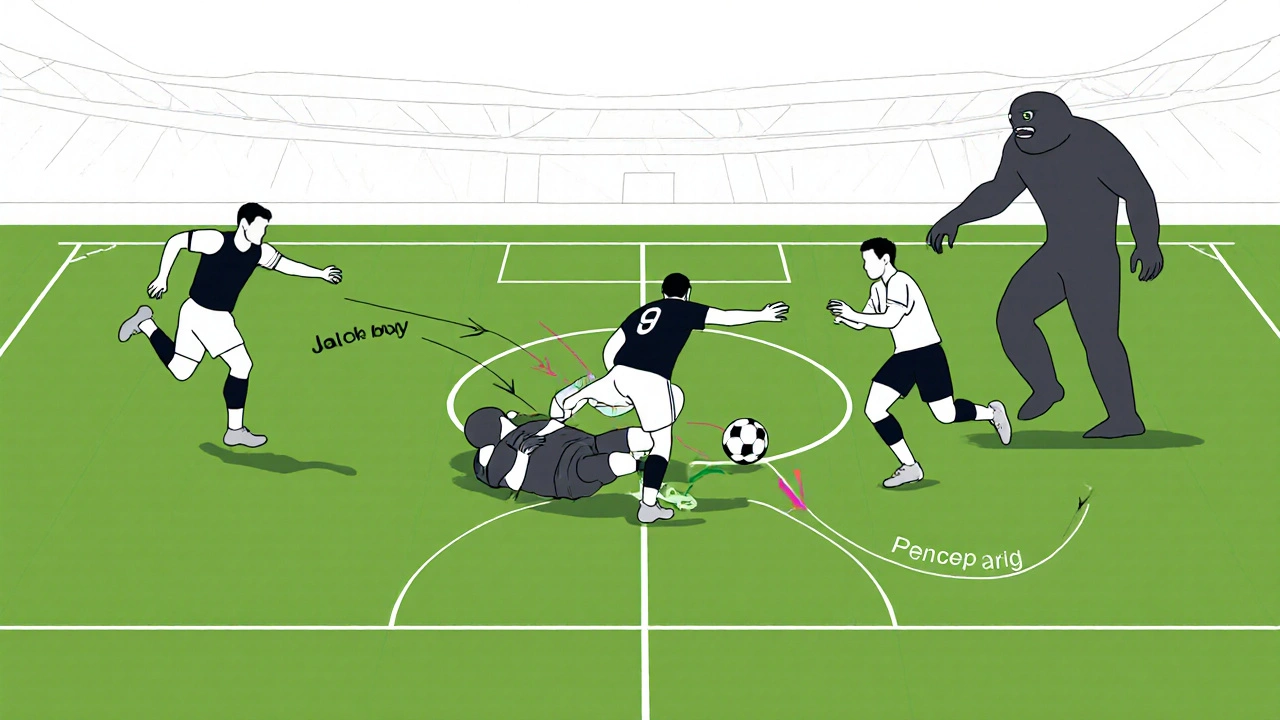Jackal in Rugby Explained: Definition, Role & Why It Matters
 Oct, 26 2025
Oct, 26 2025
When you hear fans shout “jackal!” during a match, they’re reacting to Jackal (rugby) is a defensive manoeuvre where a player tries to win the ball back at the breakdown by diving onto it before the opposition can secure possession. In plain English, a jackal is the player who swoops in like a scavenger, hoping to steal the ball and give his team a fresh set of phases. jackal rugby has become a buzzword in coaching circles because a well‑timed jackal can swing momentum in seconds.
What exactly is a jackal?
A jackal is not a position; it’s a specific action performed during the breakdown. The breakdown starts the moment a tackled player goes to ground and the ball is on the ground. At that instant, players from both sides compete for control. The jackaler’s job is to slide in, grip the ball, and either pull it out or hold it long enough for a teammate to support.
Historical roots - where did the term come from?
The word “jackal” was borrowed from wildlife slang, likening a player who scavenges the ball to the opportunistic African jackal. It entered rugby‑union commentary in the early 1990s, popularised by TV pundits watching the professional era blossom. In rugby league, the same action is often called “stealing the ball” rather than “jackaling,” but the technique is identical.
How the jackal fits into the breakdown
The breakdown is a contested area that includes three core concepts: the Breakdown is the phase after a tackle where players vie for the ball on the ground, the Ruck is a formation of players over the ball after it has been brought to the ground, and the Tackle is the act of bringing an opponent to the ground to stop forward progress. A jackal steps in right after the tackle, before the ruck fully forms.
World Rugby Law 15 - the legal side of jackaling
World Rugby’s Law 15 is the law governing the breakdown, ruck and tackled player. It states that a player must be on their feet and enter from their own side of the tackled player to be legal. Failure to release the ball or joining the ruck hands‑first results in a “hands in the ruck” penalty, usually a yellow card. The law also defines the off‑side line as the hind‑foot of the tackled player, so jackalers need to watch their positioning carefully.
Step‑by‑step jackaling technique
- Identify the ball: As soon as the tackled player is on the ground, glance for the ball’s exact location.
- Approach at an angle: Drive in from the side rather than straight on to avoid a penalty for “not releasing”.
- Get low: Bend your knees, keep your back straight, and place your shoulder close to the ball.
- Secure the grip: Use both hands - one over the top of the ball, the other underneath - to clamp down.
- Pull or hold: If the opposition’s carrier is still on the ball, yank it away; if they’re already gone, hold it until your scrum‑half or supporting player arrives.
- Stay on feet: As soon as you have the ball, stand up quickly to avoid a “hands in the ruck” infringement.
Key differences between rugby union and rugby league
| Aspect | Rugby Union | Rugby League |
|---|---|---|
| Legal zone | On‑side of the tackled player and on feet | Anywhere around the play‑the‑ball |
| Offside line | Must stay behind the hind‑foot of the tackled player | Must stay behind the marker (10‑metre line) |
| Penalty for early entry | “Hands in the ruck” - 3‑minute sin‑bin | “Holding down” - 10‑meter penalty |
| Use of hands | Allowed only while on feet and after the ball is bound | Hands can be used once the play‑the‑ball occurs |

Famous jackalers and what we can learn from them
Former Australian flanker David Pocock is renowned for his relentless jackaling and turnover skills. He logged an average of 2.3 turnovers per game during his peak years, a figure that still ranks among the highest in Super Rugby history. New Zealand’s Sam Cane is another example of a forward who turns jackaling into a weapon, often disrupting opposition ball just outside the ruck. Both players keep a low centre of gravity, eyes glued to the ball, and transition instantly from jackal to ball‑carrier.
Statistical impact - case studies
A 2023 Six Nations analysis found that teams with more than eight turnovers per game won 73% of their matches. In the 2024 Rugby World Cup quarter‑final, England’s jackal count jumped from an average of 1.4 to 3.1 after tactical changes, and they turned a 10‑point deficit into a win. The data underscores that each successful jackal adds roughly a 5% boost to win probability, especially in close contests.
Common pitfalls and how to avoid them
- Arriving too early: If you enter before the tackled player is on the ground, you’ll be penalised for “not releasing”.
- Getting trapped: Failing to stay on your feet can lead to a “hands in the ruck” call.
- Missing the grip: A weak hand position lets the opposition’s hooker pile over and retain possession.
- Over‑committing: If you dive in and the ball is already in a teammate’s hands, you risk a dangerous tackle.
Fitness and conditioning for jackalers
Jackaling demands explosive lower‑body power and strong grip endurance. Strength coaches recommend a mix of squat jumps, dead‑lift variations and farmer’s‑walks to develop the core and forearm strength needed for rapid ball‑snatches. Conditioning drills should mimic the intermittent nature of a match: 15‑second bursts of high‑intensity effort followed by 30‑second active recovery, reflecting the typical breakdown cadence.
Mental cues and decision‑making
Successful jackalers develop a pattern‑recognition instinct. They ask themselves three quick questions: Is the ball on the ground? Am I onside? Is the ball still contested? Training with video replay helps cement these cues, turning split‑second decisions into automatic responses.

Training drills to sharpen your jackaling
Coaches favour small‑sided “breakdown boxes”. Set up a 5‑by‑5‑metre area, have a tackler go down, and let two defenders race to jackal the ball. Rotate players every 30 seconds to simulate game‑speed fatigue. Another drill is “monster‑jackal”: a larger player acts as a “monster” trying to keep the ball, while three smaller players attempt to strip it away. This forces the jackaler to practice low body‑position and rapid hand placement under pressure.
Coach’s perspective - integrating jackal drills into a weekly plan
A typical elite program dedicates a 20‑minute block on Tuesdays to breakdown work, combining video analysis, the “breakdown box” drill, and a short scrimmage where coaches award points for each successful jackal. On Fridays, the focus shifts to conditioning - high‑intensity interval training that mirrors the repeated‑effort nature of turnovers. The key is consistency; jackaling improves only when players repeat the exact movement under fatigue.
Why jackaling matters for the team’s strategy
Turnovers are statistically linked to winning matches. A 2023 analysis of the Six Nations showed that teams with more than 8 turnovers per game won 73% of the time. Jackaling boosts those numbers without needing a set‑piece or a kick. It also creates a psychological edge - opponents know they can’t trust the ball to stay with them after a tackle.
Quick checklist before you step onto the field
- Know the off‑side line for your code (union vs. league).
- Keep your shoulder width narrow and stay low.
- Practice the two‑hand grip on a training ball.
- Review recent penalty stats - avoid “hands in the ruck”.
- Communicate with the scrum‑half; let them know you have the ball.
Wrap‑up - mastering the jackal
Jackaling isn’t a flashier skill than a line‑out steal, but it’s a workhorse that can decide tight games. By understanding the law, perfecting body position, and drilling consistently, any forward can become a reliable jackal. The next time you hear the crowd chant “jackal!” you’ll know exactly why that moment could be the turning point.
Is jackaling allowed in rugby league?
Yes, league players can strip the ball at the play‑the‑ball, but the off‑side rules differ. They must stay behind the marker and cannot enter the tackle area early.
What’s the biggest penalty for a bad jackal?
In union, a “hands in the ruck” infraction can earn a yellow card (3‑minute sin‑bin). In league, it usually results in a 10‑meter advancement for the opposition.
How many turnovers does an elite jackaler make per game?
Top performers like David Pocock average around 2‑3 turnovers per match, with some games hitting four or five.
Can a hooker jackal?
Absolutely. Hookers are often at the heart of the breakdown and can jackal effectively if they stay low and time their entry.
What drills improve jackaling speed?
Breakdown‑box drills, “monster‑jackal” exercises, and speed‑bag hand‑grip drills all help develop quick reflexes and a solid grip under pressure.